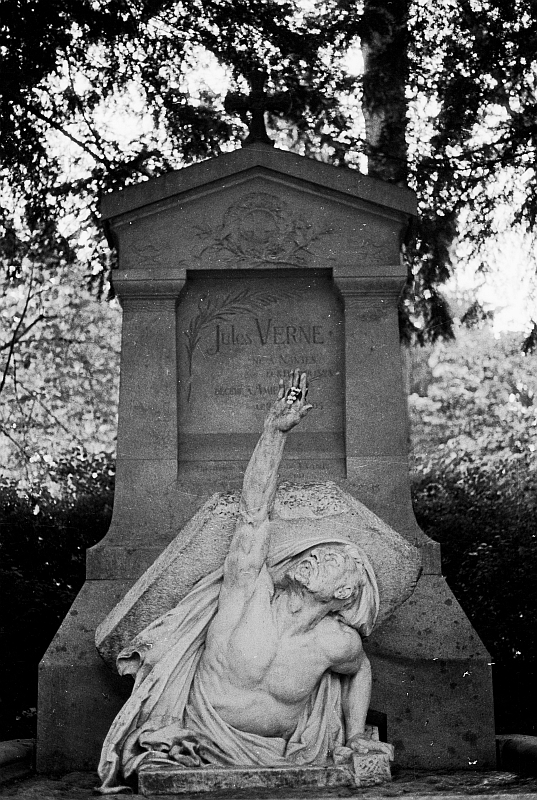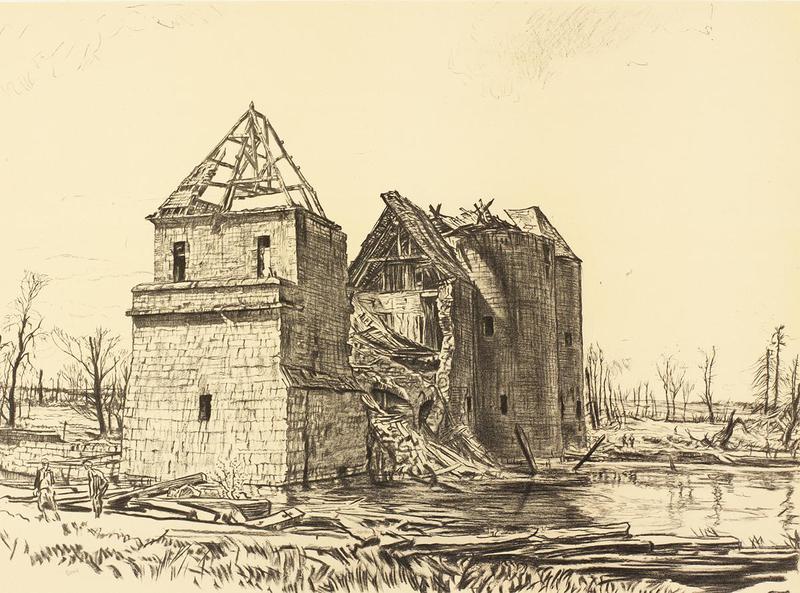|
The Golden Virgin
The Golden Virgin, which is also known as The Leaning Virgin is a Gilding, gilded sculpture the depicts the Virgin Mary offering up Baby Jesus skyward. The sculpture stands atop the Basilica of Our Lady of Brebières, a Catholic Church in Albert, France. It was sculpted by Albert Roze and was nearly toppled by Artillery, shellfire in the 1916 Battle of the Somme. It became a symbol of resilience and a great visual icon during World War I. The original statue was damaged and leaning in 1915, and went missing after it fell in 1918 as a result of a British bombardment. The statue's destruction was elevated to mythical proportions. The anticipated toppling of the statue was superstitiously ascribed as having an effect on the outcome of the war. It was later recast and replaced. Materials The Golden Virgin sculpture was covered with thousands of gold leaf, gold leaves. Pope Leo XIII christening, christened the church and seeing the Golden Virgin, he called the basilica the “Lourde ... [...More Info...] [...Related Items...] OR: [Wikipedia] [Google] [Baidu] |
Albert Roze
Albert Auguste Roze (1861-1952) was a 19th century sculptor from Amiens, France. He was a prolific sculptor creating many notable works displayed in public spaces in France. Career One of his more important sculptures was entitled The Golden Virgin; it was destroyed in 1915 during World War I. The sculpture was placed on top of the Basilique Notre-Dame de Brebières. After World War I the statue was never recovered. The sculpture of the Golden Virgin was recast and fitted atop the 76 meter bell tower A bell tower is a tower that contains one or more bells, or that is designed to hold bells even if it has none. Such a tower commonly serves as part of a Christian church, and will contain church bells, but there are also many secular bell tower ... in 1929, during the reconstruction of the Basilica 1927–1931. Designs Awards *Gold medal at the 1897 Salon of French Artists.Roze de Picardie, Albert Roze sculpteur 1861-1952, DVD réalisé par Véronique Parré, d'après les ... [...More Info...] [...Related Items...] OR: [Wikipedia] [Google] [Baidu] |
Lourdes
Lourdes (, also , ; oc, Lorda ) is a market town situated in the Pyrenees. It is part of the Hautes-Pyrénées department in the Occitanie region in southwestern France. Prior to the mid-19th century, the town was best known for the Château fort de Lourdes, a fortified castle that rises up from a rocky escarpment at its center. In 1858 Lourdes rose to prominence in France and abroad due to the Marian apparitions claimed to have been seen by the peasant girl Bernadette Soubirous, who was later canonized. Shortly thereafter the city with the Sanctuary of Our Lady of Lourdes became one of the world's most important sites of pilgrimage and religious tourism. History Antiquity The current municipal area of Lourdes was inhabited in prehistoric times. In Roman times it had to be, since the first century BC, an oppidum hill where today stands the fortress, as is testified by the numerous finds that came to light in the second half of the nineteenth century (remains of walls, fr ... [...More Info...] [...Related Items...] OR: [Wikipedia] [Google] [Baidu] |
A Chronicle Of Ancient Sunlight
A, or a, is the first letter and the first vowel of the Latin alphabet, used in the modern English alphabet, the alphabets of other western European languages and others worldwide. Its name in English is ''a'' (pronounced ), plural ''aes''. It is similar in shape to the Ancient Greek letter alpha, from which it derives. The uppercase version consists of the two slanting sides of a triangle, crossed in the middle by a horizontal bar. The lowercase version can be written in two forms: the double-storey a and single-storey ɑ. The latter is commonly used in handwriting and fonts based on it, especially fonts intended to be read by children, and is also found in italic type. In English grammar, " a", and its variant " an", are indefinite articles. History The earliest certain ancestor of "A" is aleph (also written 'aleph), the first letter of the Phoenician alphabet, which consisted entirely of consonants (for that reason, it is also called an abjad to distinguish ... [...More Info...] [...Related Items...] OR: [Wikipedia] [Google] [Baidu] |
Henry Williamson
Henry William Williamson (1 December 1895 – 13 August 1977) was an English writer who wrote novels concerned with wildlife, English social history and ruralism. He was awarded the Hawthornden Prize for literature in 1928 for his book ''Tarka the Otter''. He was born in London, and brought up in a semi-rural area where he developed his love of nature, and nature writing. He fought in World War I and, having witnessed the Christmas truce and the devastation of trench warfare, he developed first a pacifist ideology, then fascist sympathies. He moved to Devon after World War II and took up farming and writing; he wrote many other novels. He married twice. He died in a hospice in Ealing in 1977, and was buried in North Devon. Early years Henry Williamson was born in Brockley in south-east London to bank clerk William Leopold Williamson (1865-1946) and Gertrude Eliza (1867-1936; née Leaver). In early childhood his family moved to Ladywell, and he received a grammar school educati ... [...More Info...] [...Related Items...] OR: [Wikipedia] [Google] [Baidu] |
Muirhead Bone
Sir Muirhead Bone (23 March 1876 – 21 October 1953) was a Scottish etcher and watercolourist who became known for his depiction of industrial and architectural subjects and his work as a war artist in both the First and Second World Wars. A figure in the last generation of the Etching Revival, Bone's early large and heavily-worked architectural subjects fetched extremely high prices before the Wall Street Crash of 1929 deflated the collectors' market. He was well known, if not notorious, for publishing large numbers of different states of etchings, encouraging collectors to buy several impressions. Bone was an active member of both the British War Memorials Committee in the First World War and the War Artists' Advisory Committee in the Second World War. He promoted the work of many young artists and served as a Trustee of the Tate Gallery, the National Gallery, and the Imperial War Museum. Early life Muirhead Bone was born in Partick, Glasgow. His parents were journalist Dav ... [...More Info...] [...Related Items...] OR: [Wikipedia] [Google] [Baidu] |
Journal Of American History
''The Journal of American History'' is the official academic journal of the Organization of American Historians. It covers the field of American history and was established in 1914 as the ''Mississippi Valley Historical Review'', the official journal of the Mississippi Valley Historical Association. After the publication of its fiftieth volume, the recognition of a shift in the direction of the membership and its scholarship led to the name change in 1964. The journal is headquartered in Bloomington, Indiana, where it has close ties to the History Department at Indiana University. It is published quarterly, in March, June, September, and December. List of editors ''Proceedings of the Mississippi Valley Historical Association'' * Benjamin F. Shambaugh (1908–14) ''Mississippi Valley Historical Review'' * Clarence W. Alvord (1914–23) * Lester B. Shippee (1923–24) * Milo M. Quaife (1924–30) * Arthur Charles Cole (1930–41) * Louis Pelzer (1941–46) * Wendell H. S ... [...More Info...] [...Related Items...] OR: [Wikipedia] [Google] [Baidu] |
Good And Evil
In religion, ethics, philosophy, and psychology "good and evil" is a very common dichotomy. In cultures with Manichaean and Abrahamic religious influence, evil is perceived as the dualistic antagonistic opposite of good, in which good should prevail and evil should be defeated. In cultures with Buddhist spiritual influence, both good and evil are perceived as part of an antagonistic duality that itself must be overcome through achieving ''Śūnyatā'' meaning emptiness in the sense of recognition of good and evil being two opposing principles but not a reality, emptying the duality of them, and achieving a oneness. Evil is often used to denote profound immorality. Evil has also been described as a supernatural force. Definitions of evil vary, as does the analysis of its motives. However, elements that are commonly associated with evil involve unbalanced behavior involving expediency, selfishness, ignorance, or neglect. The modern philosophical questions regarding good and ... [...More Info...] [...Related Items...] OR: [Wikipedia] [Google] [Baidu] |
The Connexion
''The Connexion'' is a news website and monthly newspaper for residents, second-home owners and visitors to France. It was founded in September 2002 and currently claims just over 20,000 subscribersConnexionFrance.comreceives around 800,000 unique visitors and 2,000,000 page views every month. The print edition has a circulation of 40,000 a month. It is also on sale in 6,000 newsagents and supermarkets across France. ''The Connexion'' readership is English-speaking, consisting predominantly of British baby boomers. Most of its readers live permanently in France or own a second home there. News coverage ''The Connexion'' features coverage of French headlines and provides practical information on topical issues including COVID-19 and Brexit as well as advice on French property law, healthcare, tax and pensions in France. During the ongoing coronavirus pandemic, it has provided resources and information in English to help readers navigate lockdown rules and the vaccination campai ... [...More Info...] [...Related Items...] OR: [Wikipedia] [Google] [Baidu] |
A&E Television Networks
A&E Networks (stylized as A+E NETWORKS) is an American multinational broadcasting company that is a 50–50 joint venture between Hearst Communications and The Walt Disney Company through its General Entertainment Content division. The company owns several non-fiction and entertainment-based television brands, including its namesake A&E, History, Lifetime, FYI, and their associated sister channels, and holds stakes in or licenses their international branches. History A&E was formed from the merger of the Alpha Repertory Television Service and the Entertainment Channel, a premium cable channel, in 1984 with their respective owners keeping stakes in the new company. Thus A&E's shareholders were Hearst and ABC (from ARTS) and Radio City Music Hall (Rockefeller Group) and RCA, then the parent of NBC (from Entertainment Channel). The company launched Arts & Entertainment Network, a cultural cable channel, on February 1, 1984. In 1990, after having aired episodes of its origin ... [...More Info...] [...Related Items...] OR: [Wikipedia] [Google] [Baidu] |
Albert Cathedral "as It Is To-day" (19705521768)
Albert may refer to: Companies * Albert (supermarket), a supermarket chain in the Czech Republic * Albert Heijn, a supermarket chain in the Netherlands * Albert Market, a street market in The Gambia * Albert Productions, a record label * Albert Computers, Inc., a computer manufacturer in the 1980s Entertainment * ''Albert'' (1985 film), a Czechoslovak film directed by František Vláčil * ''Albert'' (2015 film), a film by Karsten Kiilerich * ''Albert'' (2016 film), an American TV movie * ''Albert'' (Ed Hall album), 1988 * "Albert" (short story), by Leo Tolstoy * Albert (comics), a character in Marvel Comics * Albert (''Discworld''), a character in Terry Pratchett's ''Discworld'' series * Albert, a character in Dario Argento's 1977 film ''Suspiria'' Military * Battle of Albert (1914), a WWI battle at Albert, Somme, France * Battle of Albert (1916), a WWI battle at Albert, Somme, France * Battle of Albert (1918), a WWI battle at Albert, Somme, France People * Albe ... [...More Info...] [...Related Items...] OR: [Wikipedia] [Google] [Baidu] |
The Battle Of The Somme
The Battle of the Somme ( French: Bataille de la Somme), also known as the Somme offensive, was a battle of the First World War fought by the armies of the British Empire and French Third Republic against the German Empire. It took place between 1 July and 18 November 1916 on both sides of the upper reaches of the Somme, a river in France. The battle was intended to hasten a victory for the Allies. More than three million men fought in the battle of whom one million were wounded or killed, making it one of the deadliest battles in human history. The French and British had committed themselves to an offensive on the Somme during the Chantilly Conference in December 1915. The Allies agreed upon a strategy of combined offensives against the Central Powers in 1916 by the French, Russian, British and Italian armies, with the Somme offensive as the Franco-British contribution. Initial plans called for the French army to undertake the main part of the Somme offensive, supported ... [...More Info...] [...Related Items...] OR: [Wikipedia] [Google] [Baidu] |




.jpg)
